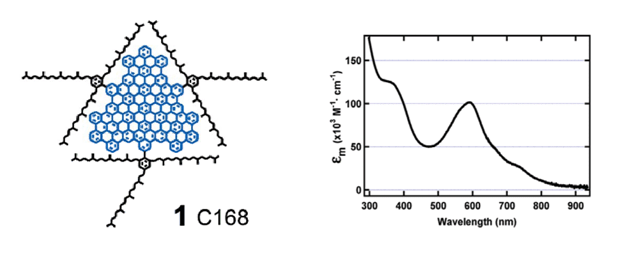AmericanChemicalSociety.com
Reports: G10 47677-G10: A New Type of Discotic Liquid Crystals for Organic Solar Cells
Liang-shi Li, Indiana University
Our goal of the work supported by the PRF grant was to create a new type of multichromatic liquid crystals for organic solar cells. The motivation was to develop a reproducible, scalable way to make “bulk heterojunctions”, simultaneously optimizing charge separation and the subsequent charge collection in organic solar cells. The proposed work contained synthesis of the discotic liquid crystal-forming compounds (mesogens) and the characterization of the solar cells. In the two-year funding period, we have achieved our initial goal of synthesizing the discotic mesogens, and are currently modifying the mesogens and characterizing their phase behaviors. Our work has led to a major breakthrough in developing a new class of solution-processable, carbon-based light absorbers, i.e., colloidal graphene quantum dots, which have superior optical and electronic properties for light harvesting in thin film solar cells. The funded work has led to two publications in Nano Letters, one in Journal of Physical Chemsitry Letters. In addition, we have submitted one more manuscript to Nano Letters, and another to the Journal of American Chemical Society. The published work has received broad media attention, and was highlighted in R&D Magazine, New Scientists, Chemical Engineering Progress and some science websites.
The major achievement in our work was the development of colloidal graphene quantum dots, which are solution-processable and absorb sunlight in the whole visible range. The first example of such is shown below (1), which contains 168 conjugated carbon atoms (marked blue) in the core. This was the largest stable graphene sheet ever made with a bottom-up approach. Due to its large size, 1 absorbs sunlight with wavelength shorter than 900 nm (absorption spectrum shown below), the optimum value for single-junction solar cells under non-concentrated light. We have demonstrated that 1 can be used as an effective light absorber in dye-sensitized solar cells.
This work opens the possibility of
making a new class of carbon-based material for solar energy utilization. An
obvious advantage of these materials, in comparison with widely used black
light absorbers including ruthenium complexes, CdTe or PbS quantum dots, is
that they are made of abundant element on earth and contain no rare or toxic
metals. Therefore we expect they have unlimited resources of raw materials and
have minimum adverse environmental impact. In addition, the colloidal graphene
quantum dots have some properties ideal for solar energy conversion. For
example, they have tunable, size-dependent bandgap and large molar absorptivity
for light absorption. Their electronic levels and interfacing with other
materials for charge transfer can both be precisely controlled with
well-developed carbon chemistry. Graphene has also been shown to have
extraordinarily high charge mobilities, which could be very useful for charge
collection in photovoltaics. In addition, our recent studies have shown that
the graphene quantum dots are unique in that that they have very long lifetimes
of high excited electronic states (i.e., “hot carriers”), potentially enabling hot electron transfer and multiexciton generation
to overcome the Shockley-Queisser limit imposed on single-junction solar
cells.

Copyright © American Chemical Society

